LD Systems MAUI 44 – Line Array – Product review by Production Partner
The development of line-mounted speaker systems has not been limited to line arrays and installations: For many applications where discreet visual impact, rapid assembly and powerful sound are required, mobile line arrangement solutions are available. One of these solutions is the MAUI 44 from LD Systems. 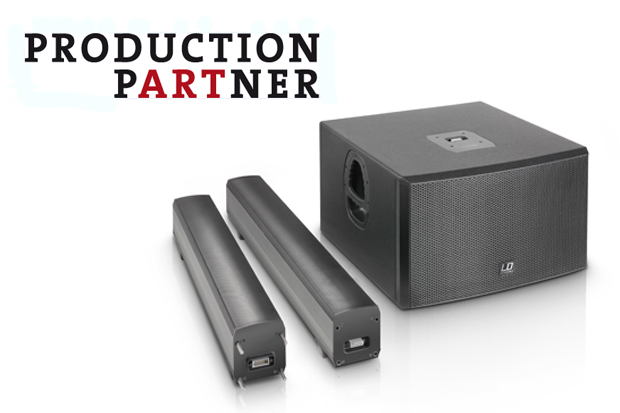 The MAUI range has been part of the extensive product portfolio of LD Systems for a number of years, and currently consists of four models: Alongside the MAUI 44 presented here – which is the company’s flagship model – there are also the MAUI 28 and MAUI 11. The 28 model comes in two versions, with or without built-in mini mixers.
The MAUI range has been part of the extensive product portfolio of LD Systems for a number of years, and currently consists of four models: Alongside the MAUI 44 presented here – which is the company’s flagship model – there are also the MAUI 28 and MAUI 11. The 28 model comes in two versions, with or without built-in mini mixers.
If you are new to the system, you may first be wondering what “MAUI” stands for. A quick email fired off to Neu Anspach soon acquired the answer: MAUI is short for “Multiple Array User Intuitive”. And this explanation promptly answers two more questions about how the system works and for which applications: The MAUI 44 is a line array system that comes in several sections which are designed for users to use intuitively according to their needs. The MAUI can serve as a classic PA system (especially for more acoustically challenged rooms), as a DJ system, as a stage or DJ monitoring system and as a ‘personalized PA system’, where each musician on stage has their own small PA that also functions as a monitor.
Its array assembly delivers tight vertical sound dispersion, while horizontal dispersion is spread more broadly. This is extremely beneficial for projecting sound in rooms with a flat or only slightly upward-sloping audience area. An important prerequisite for good acoustics – maximizing the sound projected directly towards the audience while blocking out as much interference from all other areas as possible. The array comes with its own subwoofer containing the associated electronics and providing a solid base for the whole system.
This type of assembly is identical for all MAUI systems. The systems do however differ in terms of their components and equipment. The smallest MAUI 11 comes with eight 3″ drivers, one 1″ tweeter and two 6.5″ woofers. The next biggest system, the MAUI 28, doubles up in length with 16 3″ inch drivers, while two 8″ subwoofers take care of the bass range. The largest MAUI system presented here is the MAUI 44, which has sixteen 3.5″ full-range speakers, two 1″ tweeters with special waveguides and two 12″ subwoofers. Complete with 2 x 800 W amplification, this system qualifies as a compact, all-in-one PA system.
The array
PA loudspeakers in array form have sprung up like wild mushrooms in recent years – and the analogy here is more than just a symbolic one. A typical facet of this type of loudspeaker is a subwoofer unit that also acts as a base from which a narrow column rises up to a height of 2m. The column is split into two sections for easy portability. So much for the concept. 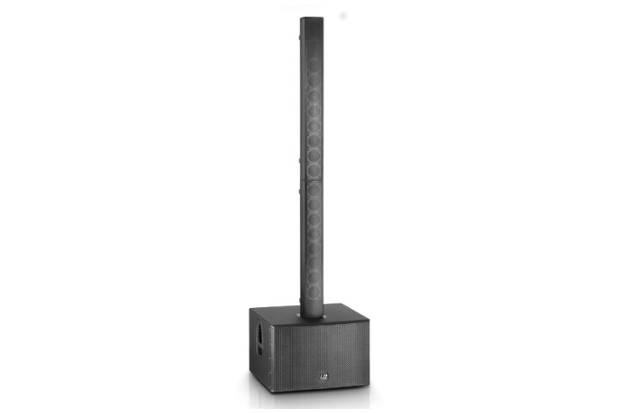 The systems differ majorly in terms of equipment, either simply sitting on full-range speakers or alternatively with additional tweeters set on top – or also as a second array in front or next to the full-range speakers. Just sitting on full-range speakers, we hear you cry?
The systems differ majorly in terms of equipment, either simply sitting on full-range speakers or alternatively with additional tweeters set on top – or also as a second array in front or next to the full-range speakers. Just sitting on full-range speakers, we hear you cry?
Many turn their nose up at the thought, assuming that this means compromised sound quality and old dusty-looking loudspeaker line-ups – definitely not the case with the modern driver. Even 4″ full-range speakers can deliver sound performance that more than holds its own next to that of 2-way systems.
A second basic consideration is whether to operate the array as one complete unit or as split sections (in order to influence vertical acoustic effect). With all the drivers operating lined up parallel to one another, the array functions as one long in-line source, with a cylindrical wavefront strictly limited to the height of the array which, when positioned far away, opens out, starting with a small beam width.
The overall result is very tight vertical audio dispersion with increasing frequency. Users basically wanting this sound but not in such sharply defined form and in less frequency-dependent style can shorten the effective length of the array with increasing frequency. This latter capability is offered by the MAUI 44 too.
The 16 full-range speakers are split into four groups: All loudspeakers initially function together for low frequencies. Via graduated low pass filters, groups are then gradually faded out, leaving just one of the group of four still active above 2 kHz. The length of the array thus remains more or less constant in relation to the wavelength, as does the directivity. This principle is well-known from modern DSP-controlled arrays and has already been successfully practised with passive or acoustic filters.
The MAUI 44 also contains the two tweeters which each separately function in passive mode with the top row of four full-range speakers. The overall result for the user is a loudspeaker with wide horizontal dispersion and (more or less well-controlled) narrow vertical dispersion. Another far from inessential positive aspect of the MAUI 44 in contrast with “normal” loudspeakers is its very subtle and sleek design.
Used properly then, these loudspeakers provide a host of major benefits, especially in rooms with problematic acoustic conditions. The special audio dispersion capability allows precise sound results on flat-surface or slightly upwardly-sloping audience areas, without filling the rest of the room with unnecessarily excessive sound or also reverberation. This is a major advantage to using the loudspeaker arrays in churches with reverberation issues.
MAUI 44: Six-way combination
The MAUI 44 array comprises two components each 1.2 m in length which are mounted on to the 60-cm tall subwoofer as a base. The central high-tone section is always positioned a significant distance above head height. The lower of the two tweeters is also mounted at a slightly downward facing angle of 7° in order to shield the frontal area. Both column elements are made from aluminum continuous casting and are fitted with two handles on their reverse to enable easy portability. The elements are connected one below the other and also fixed to the subwoofer via four solid metal pins and a multi pin connector.
The pins ensure a secure hold and allow the connector to be guided in straight. This safely avoids possible damage caused by not setting the elements up straight or by the elements wobbling. Before we measure the overall MAUI system, it’s time to measure the single frequency groups, without filtering. Measurement of the sound took place at 6-meter intervals on the central axis of the array. Figure 1 shows the results: Despite having the same components, the frequency responses for the three lower frequency groups varied significantly, as the angle to the reference axis also has a significant influence even when positioned 6 m away.
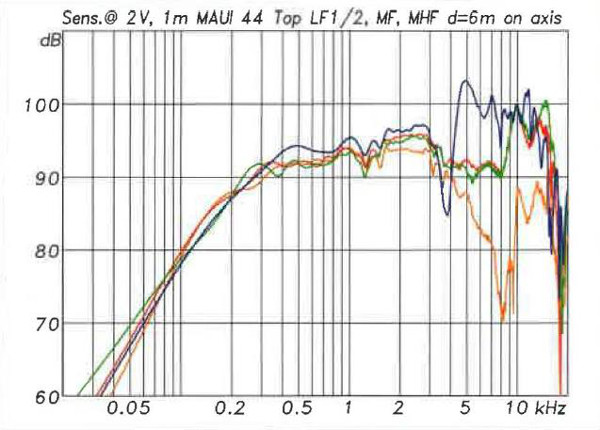
The red and green curves indicated the performance of the units below and above the central axis, each with four 3.5″ drivers. The orange curve represents the lowest unit. Blue shows the uppermost four full-range speakers and the passively installed tweeters. The sharp drop of high frequencies for the bottom unit is due to the large angle to the central axis.
The basic problems of “correctly” or meaningfully measuring performance of this type of loudspeaker are revealed here. If the MAUI 44 is standing on the floor then the central axis selected in that case lies exactly 1.6 m above the ground and thus at ear level. The red and green curves represent particularly impressive results, demonstrating the quality of the full-range speakers, which would probably also return good results without additional tweeters.
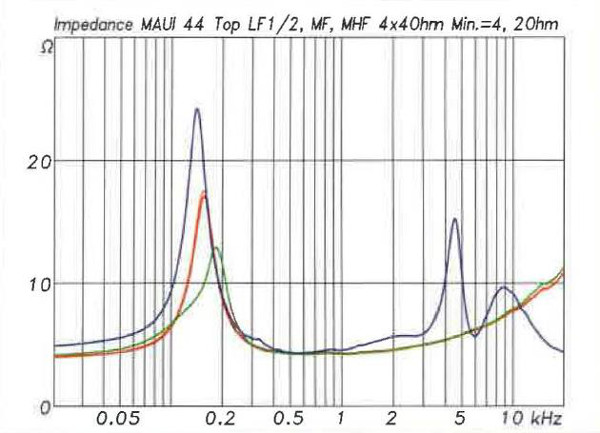
Figure 2 shows the impedance values for the four units. The minimum result in all cases is 4.2 Ohms. The feedback frequencies are between 140 and 180 Hz. The differences derive from the differing mounting variants and drivers. The blue curve for the top unit also includes the tweeter and the passive crossover switch.
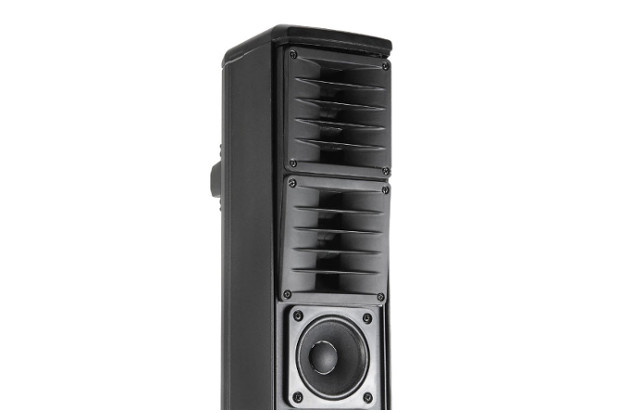
Subwoofer
The related subwoofer is equipped with two 12″ drivers and is set up as a single-chamber bandpass woofer. Both drivers work with the reverse on a closed volume and with the front in a bandpass chamber that disperses sound via a resonator.
This type of cabinet enables a compact set-up with relatively low tuning. And on top of all this, the drivers also benefit from excellent protection. Figures 3 and 4 show the frequencies and impedance values for the subwoofer (measured without filter). With a sensitivity rating of 97 dM and a lower ((base frequency/filter cutoff??)) of 45 Hz, the compact system still achieved excellent results here.
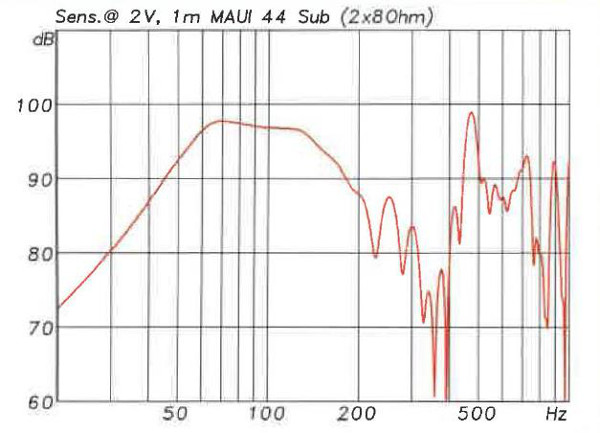
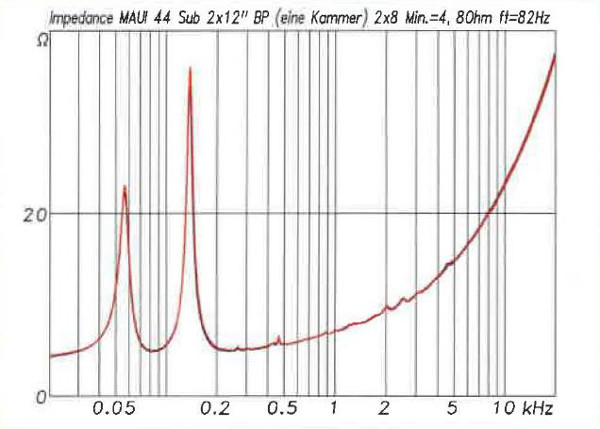
Electronics for top and sub
The subwoofer in the MAUI 44 set acts as both a base for the column element and also houses all the electronic components. These components are accommodated in their own chamber, separated from the loudspeaker itself, in order to protect them from excessive vibration. On the back of the woofer are two symmetrical XLR inputs with link sockets and also two cinch inputs.
For adding another subwoofer, the slave sub output is available – the MAUI 44SE (SE = Sub Extension) can be connected to this. The MAUI 44SE is a fully standalone subwoofer with its own electronics, including DSP system. This enables it to be used in conjunction with other top elements. The electronic components include two Hypex UcD400 power amplifier modules including the associated Hypex network elements, each with a 400 W output for both drivers in the subwoofer and four 200-W power amps for the four speaker groups in the columns. The smaller power amplifiers are set up in twos and are also served by two power cables. Exhaust heat is transferred away to the back of the woofer via robust aluminum outlets. A fan is not required due to the low-level wastage.

All signal-handling functions are executed on a DSP board with an ADAU1701 processor by Analog Devices. The filters used here for the four speakers in the column and the subwoofers are shown in figure 5. The blue curve for the mid-high frequency channel is the only channel without a low-pass filter shown by the graphic to reach the upper limit at 20kHz. The three frequencies lower down in the column are filtered out via low-pass filters at 600, 850 and 1500Hz. The separation from both high frequencies at around 4kHz takes place via a passive filter in the column. The column transfers sound to the subwoofer at around 150 Hz. The relatively high cut-off point causes no problems here because the top sections and the subwoofer are constructed such that they are always located in close proximity to one another.

In contrast, the column’s high-pass filter reading is quite prominent. The top frequency (blue curve) is cut off at a somewhat earlier point. In this context it is also particularly worth noting that the four full-range speakers in the mid-high range block are of a different model to the other twelve drivers. On the photo of the top section of the column without the grille, the different membranes can be clearly seen.
The reason for having different types of drivers could be down to the fact that the top four are optimized for mid-high frequency playback while the other twelve are designed for the low-frequency range. Taking overall measurements for the MAUI 44 system poses the same problem that applies to individual systems: it is difficult to identify one meaningful and informative measuring point. Figure 6 shows the frequency responses, again at a distance of 6 m at ear level and on the central axis between the two column elements. The narrow drop below 4kHz is due to interference with and between both high frequencies and is also caused by angles. The related phase response depicted in Figure 7 confirms, as expected, very pronounced phase shifts caused by the multi-stage low-pass filtering and the all-pass filter required for adjustment.
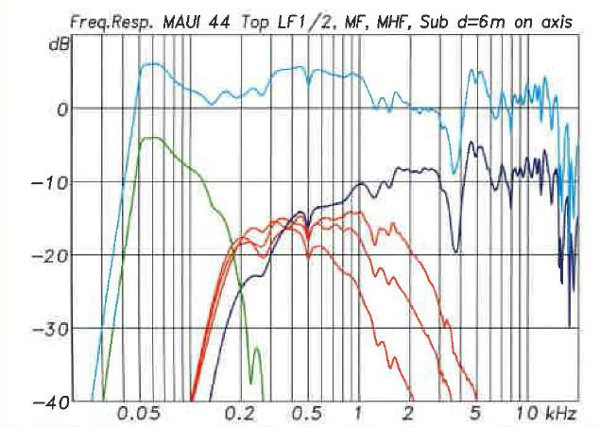
 In the spectrogram shown in Figure 8, the full-range speakers demonstrate their qualities. Membrane resonance is almost invisible. There is a slightly longer and very limited reverberation at just one point (at 500 Hz), probably attributable to the cabinet reverberating.
In the spectrogram shown in Figure 8, the full-range speakers demonstrate their qualities. Membrane resonance is almost invisible. There is a slightly longer and very limited reverberation at just one point (at 500 Hz), probably attributable to the cabinet reverberating.  Directivity For directivity results, the familiar problem of expanding the source and selecting a measuring point recurs. However, the situation for horizontal measurement is an easier one as the array performs comparably to a single system. Looking at the relevant isobars here in Figure 9 we see, for the mid and high frequencies from 1.6 kHz and above, a beam width of 100-120 degrees. Below 1.6 kHz the audio dispersion broadens dramatically to around 220 degrees due to the width of the front panel.
Directivity For directivity results, the familiar problem of expanding the source and selecting a measuring point recurs. However, the situation for horizontal measurement is an easier one as the array performs comparably to a single system. Looking at the relevant isobars here in Figure 9 we see, for the mid and high frequencies from 1.6 kHz and above, a beam width of 100-120 degrees. Below 1.6 kHz the audio dispersion broadens dramatically to around 220 degrees due to the width of the front panel. 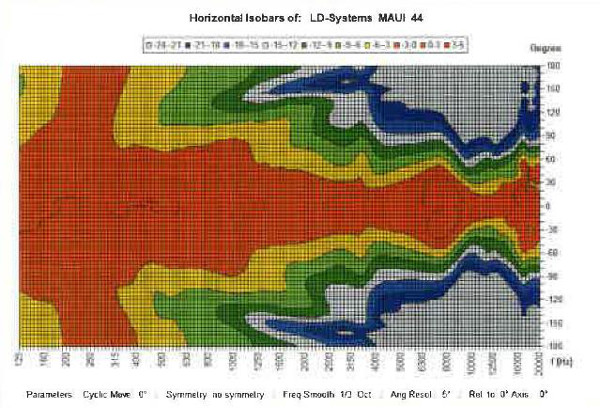 On the vertical planes, a pronounced tightening of dispersion can be seen across a wide frequency range, in line with the expectations for an array of this size. But the otherwise normally steadily increased narrowing is not seen here because, as a result of the graduated low-pass filtering, the effective length of the array reduces as the frequency increases. The isobars settle down from the point where the tweeters come into play.
On the vertical planes, a pronounced tightening of dispersion can be seen across a wide frequency range, in line with the expectations for an array of this size. But the otherwise normally steadily increased narrowing is not seen here because, as a result of the graduated low-pass filtering, the effective length of the array reduces as the frequency increases. The isobars settle down from the point where the tweeters come into play.
The reason here lies in the interference between the full-range speakers and the two differently-angled tweeters. So, in Figure 10, if we ignore for now everything over 10kHz, we can conclude that the targeted tight and constant dispersion over a very wide frequency range was successfully achieved.
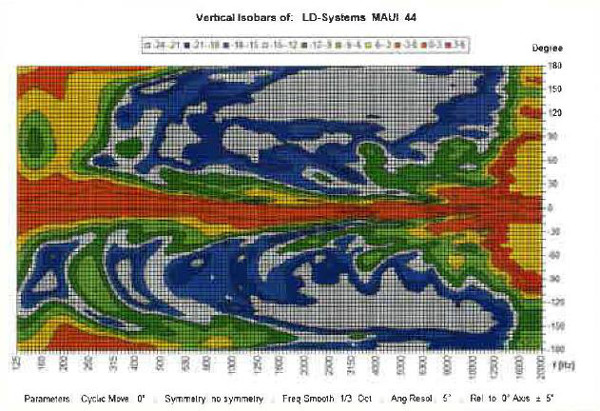
Attainable maximum level
On the subject of maximum audio level, an initial rough estimate is always recommendable. The measurements for the four-up sections with full-range speakers show a medium sensitivity rating of 92 dB 1 W / 1m. For each frequency, a power output of 200 W (+23 dB) is available, resulting in a maximum level of 115 dB. If these four units are operated simultaneously, then the achievable level increases, dependent on the frequency and arrangement in relation to one another from 6 to a maximum of 12 dB. Ignoring distortions, power compression, limitations caused by electronics, etc., expected values would range from 121 dB to 127 dB.
The rise in sensitivity to higher frequencies would allow an even higher level, but this is offset via low-pass filtering of the units. Figure 12 shows the relevant measurement with value limits for distortions of 3% and 10%. Very pleasing consistent values of around 120 dB were achieved, without exceeding the 10% distortion threshold or displaying any weak points. Above 2kHz, the curve then gradually declines to 100 dB at 10kHz. This form of measurement with sinusoidal bursts of 185 ms is a good way of identifying any weaknesses in certain frequency ranges.
Since the measurement signals relate to one frequency and are, at 185 ms, very long, the limiters intervene here in several instances. A second batch of measurements with multisinusoidal signals enables a better statement to be made on the achievable level and distortions in comparison with the maximum level measurement from Figure 11. The test signal has the spectral distribution of a mid-range music signal and, at 12 dB, a realistic crest factor. 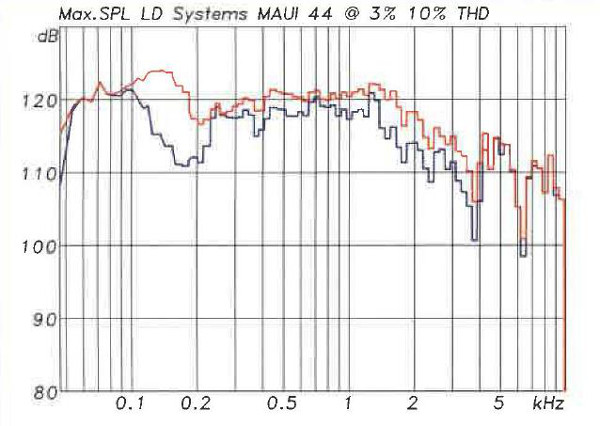 Here we see an assessment of which other loudspeaker components are also translated as distortions by the signal that do not belong to the trigger signal. The trigger signal consists of 60 sinusoidal signals, all other spectra lines are harmonic or distortion components required by intermodulation. Figure 12 shows, in this context, the spectrum of the excitation signal (green), the signal spectrum as produced by the loudspeaker (red) and the distortion levels derived therefrom (blue). An average sound level of 99 dBA at a 6 m distance in open-area conditions was set. The peak level measured here was 113 dB, also at distances of 6 m. This translates into a value of 128.5 dB per 1 m. The distortion levels measured during the evaluation amounted to a low -26 dB, respectively 5%. The 128.5 dB also incidentally correspond exactly to the figure stated in the data sheet.
Here we see an assessment of which other loudspeaker components are also translated as distortions by the signal that do not belong to the trigger signal. The trigger signal consists of 60 sinusoidal signals, all other spectra lines are harmonic or distortion components required by intermodulation. Figure 12 shows, in this context, the spectrum of the excitation signal (green), the signal spectrum as produced by the loudspeaker (red) and the distortion levels derived therefrom (blue). An average sound level of 99 dBA at a 6 m distance in open-area conditions was set. The peak level measured here was 113 dB, also at distances of 6 m. This translates into a value of 128.5 dB per 1 m. The distortion levels measured during the evaluation amounted to a low -26 dB, respectively 5%. The 128.5 dB also incidentally correspond exactly to the figure stated in the data sheet. 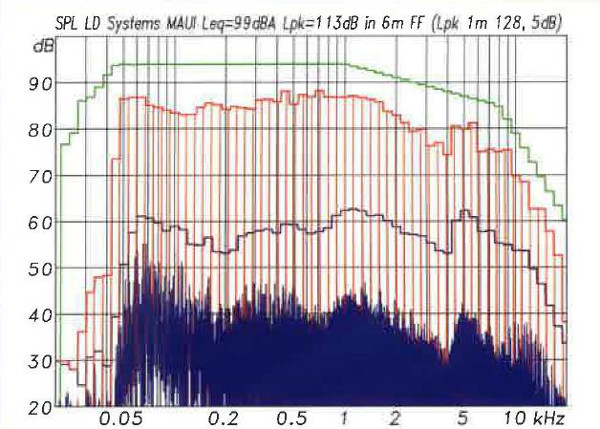
Summary
In adding the 44 model to its MAUI range, LD Systems has enhanced its offering with the large system consisting of one or two 2 x 12″ subwoofers and one 2-part, 2.4m-long array. All the electronics with six power amplifiers and a DSP system are integrated into the subwoofer. Thanks to its solid and well-conceived design, the system boasts superb portability and is very easy to assemble. And as its test results show, the four phase cell-filtering concept is proving successful. Vertical dispersion remains consistently tight across a wide frequency range. Maximum resonance levels of 120 dB with sine burst and a 129 dB peak are also impressive numbers, making the MAUI 44 ideal for larger spaces and distances or as a monitoring system on bigger stages.
The LD Systems catalog’s recommendation of the system’s capacity to provide sound to up to 400 people therefore seems deserved. If users want more powerful bass sounds, the system can accommodate an added subwoofer. In a sound test, the MAUI 44 delivered a powerful but far from overblown rich sound. Bass and treble notes were well represented without being too intrusive. The slow sound level drop-off over distance in line with the prevailing principle also produced a good result.
So to sum up, the MAUI 44 is an accomplished all-round PA system which, thanks to its compact design and easy usability combined with the excellent acoustic performance and features of a large array, looks set to bring great satisfaction to a lot of people in day-to-day operation.
And a list price of €2,399 for a full stack offering the functionality, performance and workmanship that this system does, is definitely more than justified.
_________________________________
Source: Production Partner 2/2015, Germany: http://www.production-partner.de/
Author: Anselm Goertz
For all details on the MAUI 44, go to:
http://www.ld-systems.com/en/series/maui-series/maui-44-column-pa-system-active/
Leave a Comment
You must be logged in to post a comment.












